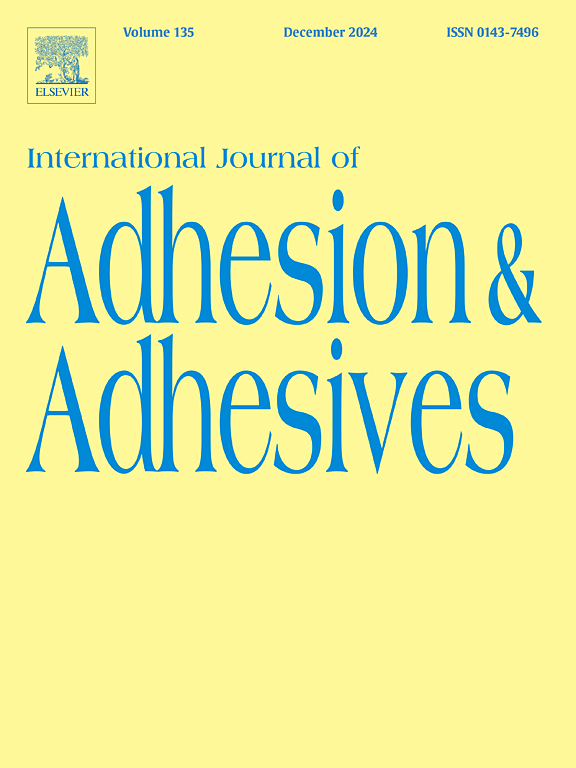Analytical model of the double-sided adhesively bonded scarf and stepped CFRP lap joint specimen under tensile loading
IF 3.5
3区 材料科学
Q2 ENGINEERING, CHEMICAL
International Journal of Adhesion and Adhesives
Pub Date : 2025-09-16
DOI:10.1016/j.ijadhadh.2025.104152
引用次数: 0
Abstract
This study aims to develop analytical models to investigate the mechanical behavior of adhesively bonded joints in double-sided scarf and double-sided stepped-lap configurations under tensile loads. More specifically, an analytical model is developed to analyze the stiffness and peak/failure load of these joint configurations connecting carbon fiber-reinforced polymer (CFRP) with for uni-directional (UD) and for quasi-isotropic (QI) adherends. The novelty of the analytical framework lies in the energy-based approach employed in its development, making it suitable for extension to complex geometries of adhesive joints and material properties of adherends. More clearly, the 1D reduced order, linear elastic framework developed here is capable of predicting the stiffness and the failure load of the adhesive joints connecting different laminate sequences with excellent accuracy. This validation is established by a comparison of the mechanical behavior predicted by the analytical model with 3D finite element (FE) simulations and experimental studies. Detailed comparisons of the global (structural) response via load–displacement curves and localized strain distributions are carried out to establish the efficacy of the model in predicting the peak loads and critical points for disbond failure of adhesive joints. The high-fidelity analytical model serves as a valuable tool for the design of improvements in double-sided adhesive joints for use in the repair of damaged composite structures. Some design recommendations are offered here towards appropriate choices for geometry and material properties of the repair patch towards the realization of desired strength and stiffness of the repaired/joined structures.
受拉荷载作用下双面胶结带-阶梯式CFRP搭接试件的分析模型
本研究的目的是建立分析模型,以研究双面丝巾和双面阶梯搭接结构的粘接接头在拉伸载荷下的力学行为。更具体地说,开发了一个分析模型来分析这些连接碳纤维增强聚合物(CFRP)与bbb16的单向(UD)和[45/−45/0/90]2s的准各向同性(QI)粘附体的连接配置的刚度和峰值/破坏载荷。分析框架的新颖性在于其开发中采用的基于能量的方法,使其适用于扩展到粘合接头的复杂几何形状和粘附物的材料特性。更清楚的是,本文开发的一维降阶线弹性框架能够以极好的精度预测连接不同层压序列的粘合接头的刚度和破坏载荷。通过将解析模型预测的力学行为与三维有限元模拟和实验研究进行比较,建立了这一验证。通过荷载-位移曲线和局部应变分布对整体(结构)响应进行了详细的比较,以确定该模型在预测粘接节点的峰值荷载和脱粘破坏临界点方面的有效性。所建立的高保真分析模型可为复合材料结构损伤修复中双面粘接的改进设计提供有价值的工具。为了实现修复/连接结构所需的强度和刚度,本文提供了一些设计建议,以适当地选择修复补丁的几何形状和材料特性。
本文章由计算机程序翻译,如有差异,请以英文原文为准。
求助全文
约1分钟内获得全文
求助全文
来源期刊

International Journal of Adhesion and Adhesives
工程技术-材料科学:综合
CiteScore
6.90
自引率
8.80%
发文量
200
审稿时长
8.3 months
期刊介绍:
The International Journal of Adhesion and Adhesives draws together the many aspects of the science and technology of adhesive materials, from fundamental research and development work to industrial applications. Subject areas covered include: interfacial interactions, surface chemistry, methods of testing, accumulation of test data on physical and mechanical properties, environmental effects, new adhesive materials, sealants, design of bonded joints, and manufacturing technology.
 求助内容:
求助内容: 应助结果提醒方式:
应助结果提醒方式:


